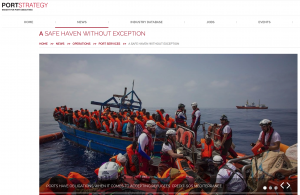COMMENT
28 December 2018
London.UK. The recent increase in migrant crossings from France to England across one of the world’s busiest shipping lanes, has prompted calls within the UK to increase sea patrols and prevent crossings. Nonetheless, the issue should not be unexpected for UK Border Force as the inevitability of exploitation of those fleeing war-torn countries by criminal gangs and human traffickers is not exclusive to North African and southern European States. The position taken by Italian authorities whereby the alleged presence of vessels capable of rescue being viewed as a pull factor to migrants is now a fear apparently being expressed by UK authorities.
Are UK authorities ready to receive increasing numbers of migrants making the crossing, and have they taken all necessary precautions to protect the rights of those rescued at sea?
Earlier this year on 30 August 2018, Felicity Landon reported in Port Strategy on the issue in her article titled: “A Safe Haven Without Exception” relating to the preparedness of ports for the reception of migrants.
The Article

“How can – or should – ports be prepared for the arrival of migrants and refugees by sea? Felicity Landon reports.
The diplomatic row surrounding the handling of the Aquarius, with 630 rescued people on board, kept the stories of migrants and refugees in the headlines in July. The Aquarius, turned away by both Italy and Malta, eventually docked in Valencia. Spain’s prime minister Pedro Sánchez said at the time: “It is our duty to help avoid a humanitarian catastrophe and offer a safe port to these people, to comply with our human rights obligations.”
A ‘Rescue at Sea’ guide produced by the International Maritime Organization, the International Chamber of Shipping, and the Office of the United Nations High Commissioner for Refugees (UNHCR) in 2015 focuses on the principles and practice relating to refugees and migrants.
It states: “Governments have to co-ordinate and co-operate to ensure that masters of ships providing assistance by embarking persons in distress at sea are released from their obligations with minimum further deviation from the ship’s intended voyage, and have to arrange disembarkation as soon as reasonably practicable.”
The Rescue Coordination Centre (RCC) first involved in any rescue should immediately accept responsibility for co-ordinating the rescue efforts, since related responsibilities, including arrangements for a place of safety for rescued persons, fall primarily on the government responsible for that region, say the guidelines.
A place of safety is defined as a location where rescue operations are considered to terminate, where basic human needs (food, shelter, medical) can be met, and where transport can be arranged for the rescued people’s next or final destination.
That place, of course, is likely to be a port. What, then, must ports do?
Obligations for ports
David Hammond, founder and trustee of Human Rights at Sea, says: “The obligation for ports is to uphold human rights at every stage and ensure the safety of all people in the port, including port workers and passengers passing through.
“This issue cuts across fundamental human rights. People who are rescued at sea are entitled to all the same human rights protection as those who rescue them and those who run the port. They are not second or third-class citizens.”
